

BISKUPIN - the best known archaeological reservation in Central Europe. Excavations at Biskupin were begun in 1934. Their scale was impressive and modern research methods were used from the beginning The excavations revealed a settlement built of wood over 2700 years ago. It had been preserved in excellent condition and before the Second World War was often referred to as the "Polish Pompeii".
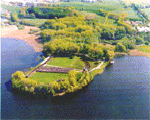 |
 |
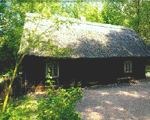 |
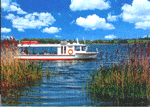 |
 |
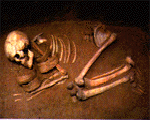 |
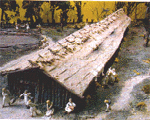 |
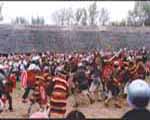 |
 |
The Lusatian culture fortified
settlement had been built on a swampy peninsula about 2 ha in area, It was surrounded by a
breakwater of slanting stakes driven into the ground and by a wooden defence rampart of a
box construction Along; the rampart ran a ring road and from this road led transverse
streets along which stood rows of houses (altogether there were about one hundred of them)
covered by common roofs. All the houses had a similar area of about 80 sq. m and were
divided into two parts - a vestibule and a main room. In the main room there was a
fireplace in the middle and on the left stood a large bed where the whole family,
consisting of 8-10 members, slept.
The settlement was inhabited by a tribe of 800-1000 people. It could be
entered through a gate in the rampart protected by a tower. A causeway/bridge, about 250
metres long led to the settlement over the water and marshy ground.
Sightseeing
We should begin
our visit at the lodge which houses the ticket office and a book and souvenir shop. Here
guides will also be waiting for us. Arrows "do wykopalisk" lead to the
excavations. The first building is a Pa│uki cottage from thesecond halt of the 18th
century with a well and sweep in front and an apiary. At the entrance to the peninsula
there are two signs, one symbolizes the sunand the universe while the other is a fertility
symbol. As we turn left and pass the landing stage of the excursion boat "Diabe│
Wenecki", we reach the plan of the settlement. From here we have the best view view
of the archaeological excavations with the remains of the wooden settlement and of the
reconstruction. Only part of the settlement has been reconstructed - the gate. two rows of
houses, one of the transverse streets and part of the rampart. The interiors of two of the
houses have been fully recreated and a third holds an exhibition of photography showing
the history of the excavations.
Through an opening in the reconstructed rampart we return to the museum
pavilion. The exhibition "The Dawn of History on Lake Biskupin" is devoted to
the history of Biskupin and its surroundings from the Late Palaeolithic, when man first
appeared in this area to the Middle Ages. In the first part of the exhibition we can see a
reconstructed camp of Neolithic hunters, a longhouse of the first farmers and the
inhumation grave of a woman with bone armlets In the Lusatian culture the dead were
usually cremated. Bodies were burned on pyres and the ashes were then placed in urns
together with food for the journey after death. When the settlement was abandoned the
population dispersed and the dead were buried in cloche graves or in cist graves built of
stone slabs.
In the part of the exhibition devoted to the Lusatian Biskupin it is
worth noting thehe reconstruction which shows the building of the settlement and the areas
where its people farmed the land, hunted and fished.
The third pan of the exhibition is devoted to Celtic and Roman
influences and early medieval times. There is a three dimensional model of the early
feudal stronghold and an exceptional silver reliquary. Here we can also see excavated
artefacts from the castle in Wenecja.
Part of the reservation, near the museum pavilion is used for purposes
of experimental archaeology, Here we can see a reconstructed stable, sheep-fold, a barn
and rick, as well as a kiln and a bread oven. For many years now small experimental fields
have been cultivated and heath sheep, red cattle, goats and Polish ponies, so-called
tarpans, have been bred here.
Every year, in the third week of September, a great
archaeological festival takes place in Biskupin ( 12th - 20th September 1998 ), at which
experts from all over Poland and from abroad demonstrate the various aspects of life in
prehistoric times. The festival attacis crowds of tourists.
Information for tourists
The Museum at
Biskupin is open everyday, all year round
from 8 a.m. to 6 p.m. ( in winter till dusk ). Biskupin is visited annually by
250 000 people. Guides arc only available for groups which have booked ahead.
Booking for groups - PMA, Biskupin, 88- 410 G╣sawa
tel./fax: ( 052 ) 30 25 025 or ( 052 ) 30 25 055.
The excursion boat sails on the lake from May to September from 9
a.m. to 5 p.m.. The trip lasts about 30 minutes.
The tour of the reservation lasts from one and a half to two hours.
There is a tourist train which runs five times daily between »nin and
G╣sawa It passes Wenecja, the ruins of the castle, the Narrow - Gauge Railway Museum and
Biskupin.
Information about accommodation and tourist attractions can be obtained
at the:
Gminny Orodek Informacji Turystycznej in G╣sawa - tel./fax:
( 052 ) 30 25 052.
| Next page |